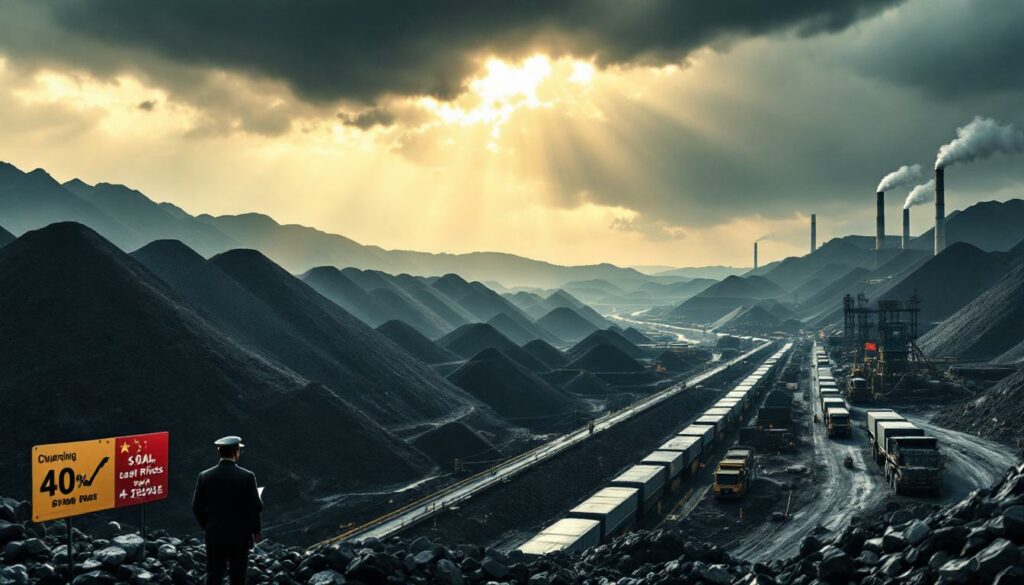Why Is China Cracking Down on Excessive Coal Production?
China's National Energy Administration (NEA) has launched sweeping inspections targeting excessive coal production, marking a significant shift in regulatory approach for the world's largest coal producer. According to data from MINING.com and Bloomberg News, coal prices have fallen to four-year lows amid a persistent supply glut that threatens both industry stability and broader economic health.
The inspections come as China's coal industry faces what industry bodies have termed "involutionary competition" – a situation where producers compete by continuously increasing output despite falling prices, creating a destructive cycle that erodes profitability across the sector.
"The oversupply situation has created a distorted market that undermines sustainable development goals and contributes to deflationary pressures in the broader economy," stated the NEA in its inspection announcement notice.
China produced nearly 5 billion tons of coal in 2024 and is tracking toward a seventh consecutive year of record production in 2025, despite clear signals of market saturation. This relentless expansion has pushed coal prices to their lowest levels since 2021, creating economic ripple effects throughout the energy and industrial sectors.
Industry Insight: Involutionary competition refers to a destructive market dynamic where producers increase output during price declines rather than reducing production, creating a vicious cycle that damages the entire industry's health and sustainability.
The current inspections represent a concrete step beyond previous verbal warnings from regulatory authorities, signaling Beijing's growing concern about industrial overcapacity and its economic consequences.
What Are the Key Details of China's Coal Production Inspections?
Inspection Timeline and Scope
The NEA's monthlong inspections, running until August 15, 2025, target operations exceeding their permitted production capacity in eight key coal-producing provinces and regions. These regions collectively account for more than 90% of China's national coal output, giving the initiative significant potential impact on supply dynamics.
The inspection teams are specifically examining operations that exceeded 110% of their designated capacity during the first half of 2025. According to NEA documentation, "designated capacity" refers to the officially approved production levels established through safety assessments, environmental impact evaluations, and resource management planning.
Regions Under Inspection
The inspections focus on China's coal heartlands:
- Primary production hubs: Shanxi, Inner Mongolia, Shaanxi, and Xinjiang
- Secondary production regions: Anhui, Henan, Guizhou, and Ningxia
Inner Mongolia alone contributed approximately 1.2 billion tons of coal in 2024, representing roughly 35% of national production, according to NEA data. Shanxi and Shaanxi follow as the second and third largest producing regions, making the current inspections particularly consequential for national supply volumes.
Potential Penalties for Non-Compliance
The NEA has clearly outlined consequences for mines found operating above permitted capacity:
- Temporary production suspensions
- Permanent closure for serious or repeat offenders
- Reduced production quotas for future operating periods
- Intensified regulatory oversight and inspection frequency
"Mines found producing at more than 110% of designated capacity during the first six months of this year will face penalties including suspensions," the NEA stated in its enforcement notice.
This represents a more stringent approach compared to previous overcapacity initiatives, which often relied on voluntary compliance rather than defined enforcement mechanisms.
How Is China's Coal Market Performing?
Current Market Conditions
China's coal market is experiencing significant downward pressure, with prices at four-year lows despite consistently rising production volumes. This price decline occurs against a backdrop of weakening demand growth in key consuming sectors like power generation, steel, and cement.
The persistent supply expansion has created what industry analysts describe as a "deeply unbalanced market" with the following characteristics:
- Growing inventory levels: Coal stockpiles at major ports and power plants have increased by approximately 24% year-over-year according to China Coal Association data
- Declining producer margins: Many smaller producers operate at break-even or loss-making levels
- Market consolidation pressure: Smaller, less efficient operations face increasing viability challenges
Industry associations have repeatedly warned about the destructive nature of this competition, where producers attempt to maintain revenue by increasing volume even as prices fall, further exacerbating the oversupply problem.
Production Trends and Forecasts
China's coal production has consistently exceeded demand growth for six consecutive years:
| Year | Production (Billion Tons) | Year-over-Year Growth |
|---|---|---|
| 2019 | 3.85 | +4.2% |
| 2020 | 3.90 | +1.4% |
| 2021 | 4.13 | +5.7% |
| 2022 | 4.45 | +8.0% |
| 2023 | 4.67 | +4.9% |
| 2024 | 4.92 | +5.4% |
| 2025 | 5.10 (projected) | +3.7% (projected) |
This persistent growth trajectory has continued despite clear market signals indicating supply saturation, contributing to the current price collapse.
Market Response to Inspection Announcements
News of the NEA inspections triggered an immediate market response, with coal mining shares rallying significantly following the announcement. Coking coal mining insights futures on the Dalian Commodity Exchange jumped approximately 15% in the days following the inspection announcement, reflecting investor expectations that regulatory action might finally constrain excess supply.
"The market has been waiting for meaningful intervention to address overcapacity," noted a commodity analyst report from S&P Global Commodity Insights. "These inspections represent the most concrete step taken so far to rein in production growth."
Why Is China Targeting Coal Overcapacity Now?
Economic Context Driving Regulatory Action
China's intensified focus on coal overcapacity stems from broader economic concerns, particularly persistent deflationary pressures that threaten growth targets. The Producer Price Index (PPI) registered at -2.4% in June 2025 according to the National Bureau of Statistics, marking the 18th consecutive month of producer price deflation.
This deflationary environment creates several economic challenges:
- Reduced corporate profitability across industrial sectors
- Increased real debt burden for producers
- Delayed investment decisions due to expectations of continued price declines
- Diminished tax revenue from resource sectors
"Overcapacity aggravates deflation by creating persistent downward price pressure in key industrial inputs," stated China's economic planning authority in a recent analysis published in People's Daily. "Addressing structural imbalances in production capacity has become essential for economic stabilization."
Broader Industrial Overcapacity Concerns
The coal sector inspections represent part of a coordinated campaign targeting excess capacity across multiple industries:
- Steel industry: Operating with approximately 100 million tons of annual overcapacity according to World Steel Association data
- Solar manufacturing: Global module oversupply estimated at 2.5 times actual demand according to International Energy Agency analysis
- Automotive sector: Electric vehicle inventory levels reaching 68 days on average, nearly double the industry target
Each of these sectors exhibits similar dynamics of overproduction, declining prices, and deteriorating profitability – a pattern Chinese authorities now appear determined to address through regulatory intervention.
Policy Significance
The current inspections signal a significant policy shift from verbal guidance to active enforcement. Previous efforts to curb overcapacity often relied primarily on industry associations issuing warnings or voluntary reduction targets, which proved insufficient to alter production behavior.
By deploying inspection teams with clear enforcement mandates and penalty frameworks, authorities demonstrate a heightened level of commitment to addressing structural imbalances. This approach aligns with recent statements from the Ministry of Industry and Information Technology emphasizing "industrial rationalization" as essential for industry transformation trends.
What Are the Potential Impacts of These Inspections?
Short-Term Market Effects
The immediate impacts of the inspections are already becoming visible in market dynamics:
- Price stabilization: Coal futures have shown early signs of recovery, with coking coal prices rebounding from multi-year lows
- Production adjustments: Reports indicate some mines in Shanxi and Inner Mongolia have already begun scaling back operations to ensure compliance
- Investor sentiment shift: Coal mining shares have rallied as investors anticipate improved supply-demand balance
- Operating discipline: Enhanced scrutiny is likely to improve adherence to approved production limits across the sector
"Suspensions may temporarily shrink the supply glut that has depressed prices," noted S&P Global Commodity Insights in a recent market analysis. "However, sustained impact will depend on enforcement consistency beyond the initial inspection period."
Long-Term Industry Implications
The broader implications of these regulatory actions could reshape China's coal industry structure:
- Consolidation acceleration: Smaller producers with limited compliance capabilities may face closure or acquisition, accelerating the trend toward larger, more efficient operations
- Investment redirection: Capital that previously funded capacity expansion may shift toward efficiency improvements and environmental upgrades
- Operational optimization: Producers may focus more on cost control and quality improvements rather than volume growth
- Supply chain restructuring: Transportation, equipment, and service providers to the coal sector may need to adapt to a more constrained production environment
For China's mining sector, these inspections could mark an important transition point from quantity-driven growth toward a more quality-focused development model that better aligns with the country's broader economic objectives.
Expert Perspective: According to data from the China Coal Research Institute, approximately 60% of China's coal mines produce less than 1 million tons annually. These smaller operations often operate with thinner margins and limited regulatory compliance resources, making them particularly vulnerable to increased enforcement actions.
How Does This Fit Into China's Broader Industrial Strategy?
Overcapacity Concerns Beyond Coal
China's coal sector inspections parallel similar initiatives across other industrial segments experiencing overcapacity challenges:
- Steel production: Winter production restrictions and capacity replacement policies requiring the elimination of older capacity before new facilities can be approved
- Solar manufacturing: Introduction of minimum efficiency standards and export quality requirements to eliminate marginal producers
- Automotive sector: New vehicle approval limitations and consolidation incentives to address fragmentation and duplication
These concurrent regulatory actions demonstrate a coordinated approach to industrial rationalization aimed at improving resource allocation and market stability across the economy.
Economic Rebalancing Efforts
The current wave of overcapacity management initiatives aligns with China's broader economic transition goals:
- Shifting from quantity to quality: Emphasis on efficiency, innovation, and value-added production rather than raw output volume
- Environmental objectives: Reducing resource intensity and pollution associated with excess production
- Supply-side structural reform: Eliminating inefficient capacity to improve overall sector profitability and sustainability
- Industrial upgrading: Encouraging higher technology adoption and productivity improvements
"Industrial rationalization is essential for high-quality growth," stated China's Minister of Industry and Information Technology in a recent Xinhua interview. "We must transform from pursuing scale alone to prioritizing efficiency, quality, and sustainable development."
This integrated approach to managing overcapacity represents a significant evolution in China's industrial policy framework, with potential long-term implications for global markets in coal and other key commodities.
FAQ: China's Coal Production Inspections
How much coal does China currently produce?
China produced 4.92 billion tons of coal in 2024 according to the National Bureau of Statistics, representing approximately 50% of global coal output. Production is on track to exceed 5.1 billion tons in 2025, which would mark the seventh consecutive year of record output despite persistent overcapacity concerns.
What penalties might non-compliant mines face?
According to the NEA enforcement notice, mines found producing at more than 110% of their designated capacity during the first half of 2025 could face several penalties:
- Temporary production suspensions
- Permanent closure for severe violations
- Reduced future production quotas
- Enhanced regulatory oversight
The severity of penalties depends on the degree of non-compliance and whether violations are repeated.
How have coal markets responded to the inspection announcements?
Coal mining shares experienced significant gains following the announcement, with major producers seeing stock price increases of 5-10% in the days after the inspection news. Coal futures also rallied, particularly in the coking coal segment, which had previously been among the hardest-hit by price declines.
This market reaction reflects investor anticipation that the inspections could meaningfully constrain excess production and help stabilize prices that had fallen to four-year lows.
Is this part of a broader economic strategy?
Yes, the coal sector inspections align with China's broader efforts to address industrial overcapacity across multiple sectors. Similar initiatives targeting steel, solar panel manufacturing, and automotive production demonstrate a coordinated approach to combating deflationary pressures and improving industrial efficiency.
These efforts reflect a strategic shift toward quality-focused development rather than volume-driven growth, supporting China mining demand and addressing energy security concerns through industry consolidation trends.
Disclaimer: This analysis represents current market conditions and regulatory developments as of July 2025. Future policy implementation may vary, and market participants should conduct their own due diligence regarding potential impacts on specific operations or investments.
Ready to Invest in the Next Major Mineral Discovery?
Discovery Alert's proprietary Discovery IQ model instantly notifies investors of significant ASX mineral discoveries, helping you capitalise on opportunities before the broader market. Visit the dedicated discoveries page to understand how major mineral discoveries have historically generated substantial returns for early investors.




